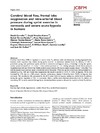Identificador persistente para citar o vincular este elemento:
https://accedacris.ulpgc.es/jspui/handle/10553/41810
| Título: | Cerebral blood flow, frontal lobe oxygenation and intra-arterial blood pressure during sprint exercise in normoxia and severe acute hypoxia in humans | Autores/as: | Curtelin Pérez, David Morales-Alamo, David Torres-Peralta, Rafael Rasmussen, Peter Martín Rincón, Marcos Pérez Valera, Mario Siebenmann, Christoph Pérez-Suárez, Ismael Cherouveim, Evgenia Sheel, A. William Lundby, Carsten Calbet, Jose A. L. |
Clasificación UNESCO: | 241106 Fisiología del ejercicio | Palabras clave: | Exercise High altitude Hypertension Cerebral blood flow Cerebral haemodynamics |
Fecha de publicación: | 2018 | Proyectos: | Oxygenación Cerebral y Fatiga Durante El Ejercicio en Hipoxia Aguda | Publicación seriada: | Journal of Cerebral Blood Flow and Metabolism | Resumen: | Cerebral blood flow (CBF) is regulated to secure brain O-2 delivery while simultaneously avoiding hyperperfusion; however, both requisites may conflict during sprint exercise. To determine whether brain O-2 delivery or CBF is prioritized, young men performed sprint exercise in normoxia and hypoxia (PIO2=73mmHg). During the sprints, cardiac output increased to similar to 22 Lmin(-1), mean arterial pressure to similar to 131mmHg and peak systolic blood pressure ranged between 200 and 304mmHg. Middle-cerebral artery velocity (MCAv) increased to peak values (similar to 16%) after 7.5s and decreased to pre-exercise values towards the end of the sprint. When the sprints in normoxia were preceded by a reduced PETCO2, CBF and frontal lobe oxygenation decreased in parallel (r=0.93, P<0.01). In hypoxia, MCAv was increased by 25%, due to a 26% greater vascular conductance, despite 4-6mmHg lower PaCO2 in hypoxia than normoxia. This vasodilation fully accounted for the 22 % lower CaO2 in hypoxia, leading to a similar brain O-2 delivery during the sprints regardless of PIO2. In conclusion, when a conflict exists between preserving brain O-2 delivery or restraining CBF to avoid potential damage by an elevated perfusion pressure, the priority is given to brain O-2 delivery. | URI: | https://accedacris.ulpgc.es/handle/10553/41810 | ISSN: | 0271-678X | DOI: | 10.1177/0271678X17691986 | Fuente: | Journal of Cerebral Blood Flow and Metabolism [ISSN 0271-678X], v. 38 (1), p. 136-150 |
| Colección: | Artículos |
Los elementos en ULPGC accedaCRIS están protegidos por derechos de autor con todos los derechos reservados, a menos que se indique lo contrario.
